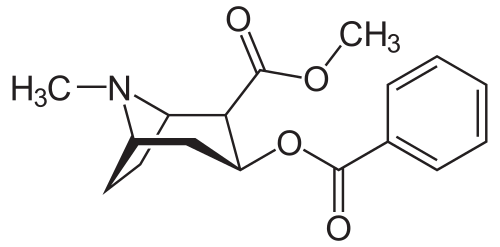Cocaine (data page)


Cocaine is a powerful stimulant drug derived from the leaves of the Coca plant native to South America. As a street drug, cocaine looks like a fine, white, crystal powder. Street dealers often mix it with things like cornstarch, talcum powder, or flour to increase profits. They may also mix it with other drugs such as the stimulant amphetamine or the synthetic opioid fentanyl.
Medical uses[edit]
Cocaine is used in medicine as a topical anesthetic, especially in otolaryngology for procedures involving the nasal, laryngeal, and oral cavities. Its ability to constrict blood vessels helps to reduce bleeding during surgical procedures.
Pharmacology[edit]
Cocaine acts by inhibiting the reuptake of serotonin, norepinephrine, and dopamine by neurons, leading to an accumulation of these neurotransmitters in the brain. This accumulation results in the stimulation of the central nervous system, increased heart rate, and blood pressure, and a feeling of euphoria.
History[edit]
Cocaine has a long history of use for various purposes. Indigenous people in South America have chewed coca leaves for centuries to increase their energy levels and endurance. Its medicinal properties were first isolated in the 19th century, and it was used in tonics and elixirs. However, due to its addictive nature and potential for abuse, its use has been highly regulated or banned in many countries.
Legal status[edit]
Cocaine is classified as a Schedule II drug in the United States under the Controlled Substances Act, meaning it has a high potential for abuse but can be administered by a doctor for legitimate medical uses, such as local anesthesia for some eye, ear, and throat surgeries.
Safety Information[edit]
When handling Cocaine in its free base form, strict safety measures must be adopted. It is crucial to consult the Material Safety Data Sheet (MSDS) from reputable sources such as the Safety and Chemical Information Resource Institute (SIRI) to obtain detailed guidance on safe handling practices. Adherence to the MSDS directions is strongly advised to mitigate potential risks.
Structural and Physical Properties[edit]
- - Index of Refraction (nD): The index of refraction is measured at 1.5022, highlighting how light bends when passing through the substance.
- - Melting Point: Cocaine's free base has a melting point of 98°C, indicating the temperature at which it transitions from solid to liquid.
- - Boiling Point: The boiling point is observed at 187°C, the temperature at which the substance changes from liquid to gas.
- - Solubility: It exhibits a solubility of 1.7 g/L in water at 25°C, showcasing its ability to dissolve to a certain extent in water.
Thermodynamic Properties[edit]
The document does not specify values for the thermodynamic properties such as the triple point, critical point, standard enthalpy and entropy changes of fusion and vaporization, and the properties pertaining to solid, liquid, and gas phases. These parameters are crucial for understanding the behavior of Cocaine under different temperature and pressure conditions, including its transition points and thermal stability.
Spectral Data[edit]
Spectral analysis data, which could provide insights into the molecular structure and interactions of Cocaine, is also not specified. This includes:
- - UV-Vis Spectroscopy: Information such as the maximum wavelength (λmax) and extinction coefficient could reveal how the substance absorbs light.
- - IR Spectroscopy: Major absorption bands would indicate the vibrational motions within the molecule.
- - NMR Spectroscopy: Both Proton and Carbon-13 NMR data could offer detailed structural information.
- - Mass Spectrometry: Masses of main fragments would assist in identifying molecular components and their relative abundances.
See also[edit]
References[edit]
<references group="" responsive="1"></references>
Ad. Transform your life with W8MD's Budget GLP-1 injections from $75


W8MD offers a medical weight loss program to lose weight in Philadelphia. Our physician-supervised medical weight loss provides:
- Weight loss injections in NYC (generic and brand names):
- Zepbound / Mounjaro, Wegovy / Ozempic, Saxenda
- Most insurances accepted or discounted self-pay rates. We will obtain insurance prior authorizations if needed.
- Generic GLP1 weight loss injections from $75 for the starting dose.
- Also offer prescription weight loss medications including Phentermine, Qsymia, Diethylpropion, Contrave etc.
NYC weight loss doctor appointmentsNYC weight loss doctor appointments
Start your NYC weight loss journey today at our NYC medical weight loss and Philadelphia medical weight loss clinics.
- Call 718-946-5500 to lose weight in NYC or for medical weight loss in Philadelphia 215-676-2334.
- Tags:NYC medical weight loss, Philadelphia lose weight Zepbound NYC, Budget GLP1 weight loss injections, Wegovy Philadelphia, Wegovy NYC, Philadelphia medical weight loss, Brookly weight loss and Wegovy NYC
|
WikiMD's Wellness Encyclopedia |
| Let Food Be Thy Medicine Medicine Thy Food - Hippocrates |
Medical Disclaimer: WikiMD is not a substitute for professional medical advice. The information on WikiMD is provided as an information resource only, may be incorrect, outdated or misleading, and is not to be used or relied on for any diagnostic or treatment purposes. Please consult your health care provider before making any healthcare decisions or for guidance about a specific medical condition. WikiMD expressly disclaims responsibility, and shall have no liability, for any damages, loss, injury, or liability whatsoever suffered as a result of your reliance on the information contained in this site. By visiting this site you agree to the foregoing terms and conditions, which may from time to time be changed or supplemented by WikiMD. If you do not agree to the foregoing terms and conditions, you should not enter or use this site. See full disclaimer.
Credits:Most images are courtesy of Wikimedia commons, and templates, categories Wikipedia, licensed under CC BY SA or similar.
Translate this page: - East Asian
中文,
日本,
한국어,
South Asian
हिन्दी,
தமிழ்,
తెలుగు,
Urdu,
ಕನ್ನಡ,
Southeast Asian
Indonesian,
Vietnamese,
Thai,
မြန်မာဘာသာ,
বাংলা
European
español,
Deutsch,
français,
Greek,
português do Brasil,
polski,
română,
русский,
Nederlands,
norsk,
svenska,
suomi,
Italian
Middle Eastern & African
عربى,
Turkish,
Persian,
Hebrew,
Afrikaans,
isiZulu,
Kiswahili,
Other
Bulgarian,
Hungarian,
Czech,
Swedish,
മലയാളം,
मराठी,
ਪੰਜਾਬੀ,
ગુજરાતી,
Portuguese,
Ukrainian
